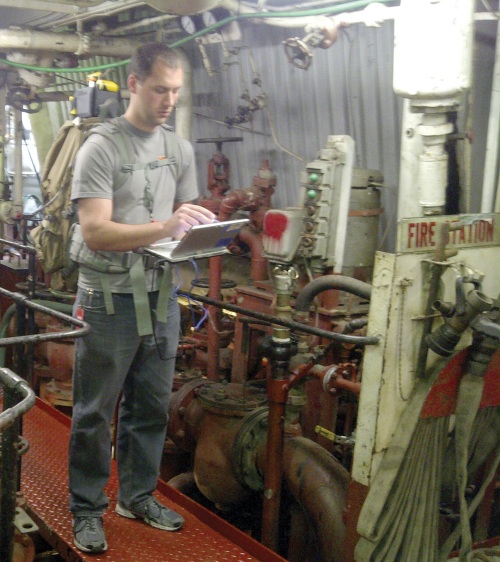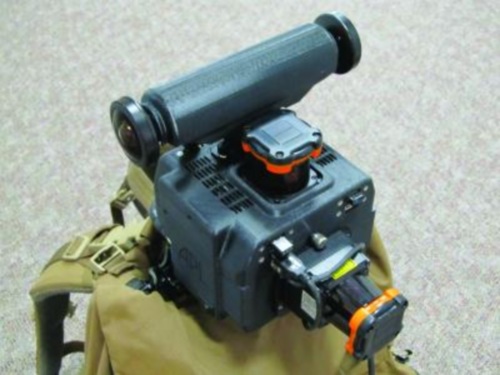Engineers from Johns Hopkins University’s Applied Physics Laboratory have created a portable mapping system that can be used to create annotated physical maps of areas where GPS is not available, including office buildings, underground locations, the inside of a ship, and more.
The technology, referred to as the Enhanced Mapping and Positioning System (EMAPS), was produced for the Defense Threat Reduction Agency. It creates a floor-plan-style map of an area traversed along with 360-degree photos and sensor readings of the area using a highly intricate combination of lasers and sensors.

An APL engineer using EMAPS aboard a ship. Below is the map he generated via the technology.

How EMAPS works
For improved accuracy, EMAPS incorporates improved-upon algorithms once developed for robots. This includes providing built-in allowance for human movement (e.g. walking) as well as being able to associate important environmental data like radiation or radio frequency signal levels with map locations.
In terms of its physicality, EMAPS is an approximately 6-inch cube that weighs a little less than 4 pounds. It gets carried around in a backpack and during the trek the system’s 270-degree laser scanner constantly measures things like distance between walls as well as environmental features too.

The APL’s EMAPS technology.
“EMAPS virtually takes pictures with every step,” says Jason Stipes, of the Force Projection Department. “Using this technology, we can map almost every nook and cranny of targeted locations, capture that intelligence, and store it. Sensors can also detect threats, such as radiation or chemicals, and include them in our map.”
A lot of technology is packed into this tiny cube
As if a 270-degree laser scanner isn’t already enough technology to be carrying around, EMAPS also has a second laser scanner to allow for 3D data collection of the surrounding environment, an inertial sensor measures roll, pitch, and yaw of the system to make up for steps taken by the user, and a removable camera system that can be used to capture omnidirectional images along a path.
What’s more, a GPS receiver can be connected to EMAPS to allow for georegistration of the data being captured, all of which is being stored and processed in real time by the system’s on-board computer.
Testing EMAPS out
In terms of testing, Stipes says that EMAPS has collected over 100 hours of mapping data from GPS-denied places like ships, underground storage facilities, Army training areas, and more. The maps generated are several miles long and in terms of type, range from office buildings to complex engine rooms aboard ships.
“The EMAPS software addresses a number of challenges using specially developed algorithms,” says Stipes. “Working with DTRA, APL engineers have created software to efficiently map data without boundaries while using a fixed amount of computer memory. And, while previous algorithms fail in open areas and long, smooth hallways, we have been able to design algorithms to map these challenging environments.”
Story via: jhuapl.edu
Advertisement
Learn more about Electronic Products Magazine





